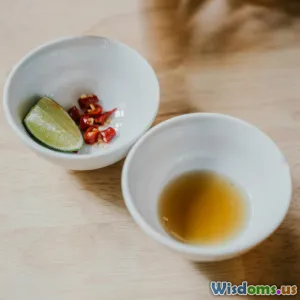
Flavors of the World: Global Ingredient Combinations
8 min read Explore how unique global ingredient pairings shape world cuisines and inspire innovative cooking. (0 Reviews)
Flavors of the World: Global Ingredient Combinations
The world’s culinary landscape is a rich tapestry woven from the distinct and diverse combinations of ingredients that each culture brings to the table. Exploring global ingredient pairings is like embarking on a flavorful journey that transcends borders—a practice that ignites creativity for cooks and food enthusiasts alike. From the aromatic spices of Southeast Asia to the hearty pulses of Latin America, every region offers signature duos that define their traditional dishes and continuously inspire innovative gastronomy.
The Power of Pairings: Why Ingredients Matter
Flavor combinations aren’t just random—they are science. The way ingredients interact shapes taste, aroma, texture, and even nutritional value. Traditional cuisines often developed unique pairings through centuries of experimentation, climate, and agricultural resources.
As food chemist Michael Tunick highlights, "Certain flavors complement each other at a molecular level, which explains why some combinations become iconic. For example, garlic and basil share aromatic compounds that balance and enhance flavor profiles."
Understanding these pairings enables chefs and home cooks to create balanced, exciting dishes.
Classic Global Combinations and Their Cultural Significance
1. Tomato and Basil – Italy’s Timeless Duo
In Italian cuisine, the pairing of ripe tomatoes with fresh basil exemplifies simplicity that yields profound flavor. This duo forms the backbone of iconic dishes like Caprese salad and margherita pizza. Basil’s sweet, peppery aroma complements the acidity and juiciness of tomatoes, creating harmony on the palate.
2. Coconut and Curry Leaf – South India’s Fragrant Blend
South Indian cooking often employs coconut and curry leaves together. Coconut’s creamy sweetness softens the slightly bitter, citrusy notes of curry leaves. Used together in chutneys and sambar, they bring an unmistakable aroma that signifies the regional identity.
3. Soy Sauce and Ginger – East Asian Umami Symphony
Soy sauce’s salty, umami quality melds seamlessly with ginger’s sharp, zesty warmth in many East Asian dishes. This pairing works in stir-fries, marinades, and dipping sauces, enhancing both meat and vegetable flavors.
4. Chili and Chocolate – Mexican Culinary Alchemy
In Mexico, chili peppers are paired with chocolate in savory moles, creating a harmony between heat and deep bitterness. This bold combination balances layers of flavor and exemplifies how ingredients far from sweet and spicy can merge beautifully.
Unexpected Ingredient Combos Revolutionizing Modern Cooking
Innovation occurs when chefs play outside traditional pairings and daringly match diverse ingredients.
Saffron and Lemon – Mediterranean Brightness
Combining the luxurious floral notes of saffron with the sharp zing of lemon creates a vibrant flavor lift. Used in seafood dishes or rice pilafs, this pairing adds dimension that is simultaneously rich and fresh.
Fermented Foods and Sweet Elements
Pairing fermented ingredients like kimchi or sauerkraut with sweet fruits (mangoes, apples) taps into a contrast that excites the palate. For example, Korean fusion cuisine uses kimchi with apple slices to juxtapose sour, spice, and sweetness.
Coffee and Blue Cheese – Bold Sensory Contrast
Though unconventional, pairing bitter coffee tones with the pungent creaminess of blue cheese has emerged in avant-garde gastronomy, outputting a taste reveal that’s rich, complex, and surprising.
The Science Behind Flavor Pairings
Flavor pairing science analyzes how shared chemical compounds influence why certain combinations work. For example, strawberries and balsamic vinegar both share phenols that enhance each other’s taste when combined.
Research from Harvard University suggests that culturally ingrained preferences often guide pairing, but exploring shared aromatic compounds broadens possibilities. This scientific approach pushes chefs to rethink traditional constraints and invent new, palatable mixtures.
How to Experiment with Global Flavor Combinations at Home
Understand Your Ingredients
Start with familiar ingredients and research their origin, flavor profile, and traditional uses. Identify whether they are earthy, sweet, bitter, or umami.
Start Simple Pairings
Introduce new ingredients gradually with known flavors. For example, mixing Thai basil into a classic basil pesto adds Southeast Asian nuances without overwhelming.
Embrace Contrast and Harmony
Balance spicy with sweet, sour with creamy, or salty with bitter to build complexity. Examples include pairing honey with mustard or avocado with pickled radish.
Use Authentic Condiments and Spices
Explore cephalopod staples such as miso, harissa, gochujang, or za’atar to infuse dishes with global essence and explore authentic flavor foundations.
Closing Thoughts: Celebrating Culinary Diversity
Ingredient combinations reflect history, environment, and culture. Delving into global pairings enriches our palates and invites greater cultural appreciation. It encourages culinary curiosity and paves the way to innovative dishes that honor tradition while embracing modernity.
As famed chef José Andrés says, “Food is a universal language; understanding its ingredients across cultures connects us all.” Through exploring the flavors of the world, we celebrate human creativity, diversity, and the endless joy of taste.
Whether you are a curious foodie or a passionate cook, experimenting with ingredient pairings from around the globe can inspire fresh meals that delight and broaden your culinary horizons. So why not start with something unique tonight—perhaps sumac with strawberries or tamarind with roasted nuts—and flavor your life with a world of possibilities?
References:
- Tunick, Michael. The Chemistry of Flavor Pairings, Food Science Journal, 2020.
- Andrés, José. Food and Culture: A Global Conversation, 2018.
- Harvard University, Flavor Science Research, 2022.
- Regional culinary archives from Italy, Mexico, India, South Korea.
Elevate your cooking by embracing the authenticity and creativity found in the world's most beloved ingredient combinations.
Rate the Post
User Reviews
Popular Posts





















